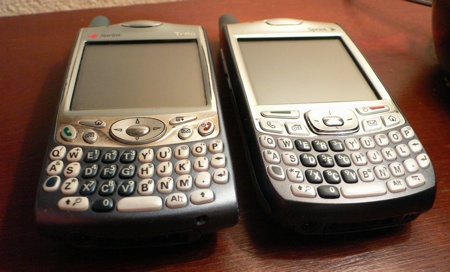Back in May, I covered the Treo 700p announcement, declaring it a worthy replacement for my current handheld, the Treo 650. I had always intended to upgrade, but I couldn’t justify the expense until recently: Last month, my service contract with Sprint expired (making me eligible for a discount on the Treo), and my wife’s cheap Nokia 6225 finally bit the dust. Solution? I got a new 700p; my wife got my old 650.
The Treo 650 (left) and Treo 700p (right)
Now that I’ve actually had a chance to use the Treo 700p, I can offer a more thorough review. First, the cons:
- I thought cell phones were getting smaller and sleeker, but the Treo 700p is just as thick and chunky as the model it replaces. After eighteen months, you’d think Palm’s hardware engineers could slim their flagship product just a little bit. Instead, the Treo remains (unofficially) the world’s fattest cell phone.
- The Menu key, a rather frequently pressed button, has been moved. It’s no longer found on the middle-right, which was a perfectly natural location for thumb usage when holding the phone in your left hand (and still very accessible when holding the phone in your right). Instead, it is now located all the way down on the lower right. Not only does this make the Menu key nearly impossible to push when holding the phone in your right hand, it requires an awkward reach of the thumb when held in the left hand. Why, Palm, why?
- The 700p has two phone buttons: a green button to answer calls and (just below it) a Phone hard key to switch to the dial pad. There’s no reason for this redundancy: On the 650, a single Phone button worked perfectly fine for both functions. Worse, the extra button takes up space that could otherwise be used for the Menu key (see above).
- With its faster EV-DO radio, the Treo is now able to play streaming video. It’s a nice idea, but I found the quality to be terrible. Instead of spending $10/month on Sprint TV, I’d rather just use my video iPod.
- Sprint now requires the purchase of a $40/month “Phone As Modem” plan if you want to use the Treo to give your laptop wireless Internet access. (The 650 only required the Vision plan at $15/month.) Luckily, a hack is available that disables the need for PAM. Full details are in my updated step-by-step guide for Bluetooth dial-up networking.
And now the pros:
- Speaking of Bluetooth DUN, this feature had to be enabled and disabled manually on the 650. It was a tedious process of switching to the Bluetooth preferences, turning on DUN, then getting a warning message about Bluetooth devices not working when DUN is enabled. On the 700p, this entire process is automatic. DUN enables and disables itself on demand, so there are no warning messages to deal with.
- The keyboard has a better feel. The keys are slightly bigger and easier to push.
- Internet access is noticeably faster. Although certainly not “broadband-like†as Sprint claims, the speed is a big improvement over the 650. In terms of raw performance, the 650 is like having a wireless dial-up connection, while the 700p is more like ISDN (somewhere between dial-up and broadband). Raw speed for downloads is about 10 KB/s on the 650 and at least 20 KB/s on the 700p, although there’s still an awful lot of latency when surfing on the 700p. Still, net access on the 650 was sometimes painful, but on the 700p it’s usually acceptable. A case in point: The Internet access at home temporarily went down last week, so I used the 700p’s DUN feature as a backup. After a few minutes, I almost forgot I wasn’t on Wi-Fi anymore!
- My favorite new feature in the 700p is one that I haven’t seen mentioned anywhere: It now charges directly from a USB port! So, instead of carrying yet another AC adapter with me when I travel, the same USB cable that I use to sync my Treo with my laptop can also be used to charge it.
That’s four pros and five cons. As you can see, I’m not quite as thrilled about the 700p as I was back in May, at least not as an upgrade from the 650. Given that the operating system, processor, and screen haven’t changed at all, and the form factor is almost the same (and worse in some ways), it’s hard to justify the cost. The only substantial improvements are the EV-DO radio and the ability to charge from USB. Keep that in mind if you’re a 650 user looking to upgrade to the Treo 700p.
